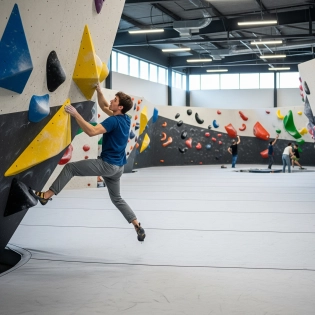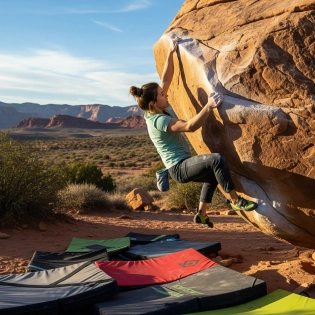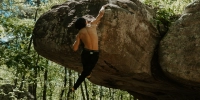
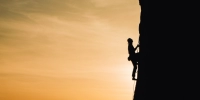






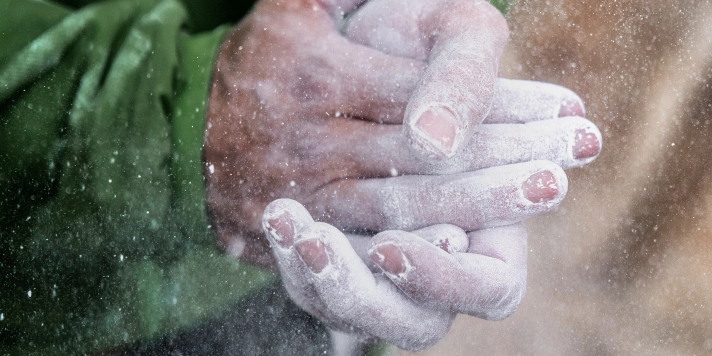
general climbing
If you don't have a Moon Board or Tension Board, focus on improving your climbing technique and overall strength. Practice precise footwork, body positioning, and efficient movement on different climbing routes. Incorporate exercises that target your core and antagonistic muscles to enhance your climbing abilities. Additionally, consider exploring other climbing gyms or outdoor climbing areas to challenge yourself on various routes.
The grade of climbs you should be able to climb largely depends on your individual climbing experience, skill level, physical fitness, and the type of climbing you are pursuing. It's important to set realistic goals and progress at a pace that is comfortable for you. Here are a few things to consider:
-
Beginner Climbers: If you are new to climbing, starting with easier routes is recommended. Focus on building a solid foundation of climbing techniques, improving your strength and endurance, and gaining experience on climbs that are well within your comfort zone.
-
Gym Climbers: If you primarily climb in a gym, the gym's grading system will help guide your progression. Start with lower-grade routes and gradually work your way up as you become more comfortable and confident. It's also beneficial to climb a variety of routes to develop diverse skills.
-
Outdoor Climbers: Outdoor climbing grades can vary widely depending on the location and grading system used. Begin by climbing routes at the lower end of the grading spectrum for the area you're climbing in. As you gain experience, you can gradually progress to more challenging climbs.
Remember that grades are subjective and can vary from one climbing area to another. They also differ between different styles of climbing, such as sport climbing, trad climbing, or bouldering. Grades are meant to provide a general indication of difficulty, but it's essential to focus on your personal progress and enjoyment of the sport rather than solely chasing higher grades.
It's a good idea to consult with experienced climbers or climbing instructors at your local gym or climbing community to receive personalized guidance and recommendations based on your specific abilities and goals. They can provide valuable insights and help you determine appropriate grades to strive for as you continue your climbing journey.
When rock climbing, there are certain actions or behaviors that should be avoided to ensure safety and maintain a positive climbing experience. Here are some things you should not do when rock climbing:
-
Neglect Safety Precautions: Never compromise on safety. Don't skip wearing a helmet, neglect to double-check knots and gear, or disregard proper belaying techniques. Always prioritize safety protocols to prevent accidents or injuries.
-
Climb Beyond Your Abilities: Avoid attempting climbs that are significantly beyond your skill level or physical capabilities. Pushing your limits is important, but it should be done gradually and with proper preparation. Climbing well within your abilities helps reduce the risk of accidents.
-
Ignore Environmental Impact: Don't damage the rock or surrounding environment. Avoid chipping or altering the rock, removing vegetation, or leaving behind any trash. Follow Leave No Trace principles and respect the natural surroundings.
-
Disrespect Climbing Ethics: Familiarize yourself with the climbing ethics and guidelines of the area you're climbing in. Don't deviate from established routes, ignore access restrictions, or engage in behavior that negatively impacts the climbing community or local regulations.
-
Disturb Others: Be mindful of noise levels and avoid disturbing others in the climbing area. Respect the space and the experience of fellow climbers by being considerate, following communication etiquette, and maintaining a positive and supportive environment.
-
Compete Unsafely: While friendly competition can be motivating, avoid engaging in unsafe or reckless behavior to outperform others. Climbing should prioritize safety and personal growth rather than unnecessary risks or comparisons.
-
Overlook Hydration and Nutrition: Don't neglect your body's needs while climbing. Stay hydrated, maintain proper nutrition, and listen to your body's signals to avoid dehydration, exhaustion, or loss of focus.
-
Neglect Continuous Learning: Avoid stagnation in your climbing skills and knowledge. Don't assume you know everything or stop seeking opportunities to learn and improve. Stay open to new techniques, safety practices, and learning from experienced climbers.
By avoiding these behaviors, you can help create a safer and more enjoyable climbing experience for yourself and those around you. Always prioritize safety, respect, and responsible climbing practices.
Rock climbing involves certain rules and guidelines that climbers should follow to ensure safety and respect for the climbing community. Here are some general rules of rock climbing:
-
Safety First: Prioritize safety at all times. This includes using proper climbing equipment, wearing a climbing helmet, and double-checking knots and gear before climbing.
-
Follow Climbing Ethics: Respect the climbing ethics and rules of the area you're climbing in. This may include sticking to designated climbing routes, avoiding damaging or altering the rock or environment, and respecting access restrictions or closures.
-
Leave No Trace: Practice Leave No Trace principles by minimizing your impact on the natural environment. Pack out all trash, avoid damaging vegetation, and be mindful of noise pollution.
-
Communicate and Collaborate: Maintain good communication with your climbing partners. Discuss climbing plans, strategies, and potential hazards before starting a climb. Work together to ensure a safe and enjoyable experience.
-
Yielding Right of Way: Be aware of other climbers on the wall and yield the right of way when necessary. If you're being overtaken by faster climbers or descending climbers, allow them to pass safely.
-
Respect Others: Treat other climbers with respect, kindness, and patience. Be mindful of noise levels, share climbing resources when needed, and maintain a supportive and inclusive climbing community.
-
Stay Hydrated and Energized: Climbing can be physically demanding, so stay properly hydrated and fuel your body with snacks or meals to maintain energy levels during climbs.
-
Continuous Learning: Strive to continually improve your climbing skills and knowledge. Stay updated on new techniques, safety practices, and climbing regulations. Take courses or learn from experienced climbers to enhance your climbing abilities.
Remember, specific climbing areas or gyms may have additional rules or guidelines that you should familiarize yourself with before climbing. Always prioritize safety, respect for the environment, and the well-being of yourself and others while enjoying the sport of rock climbing.
When rock climbers go on multi-day climbing trips or expeditions, they need to find a way to sleep in the outdoor environment. Here are a few common methods rock climbers use for sleeping:
-
Camping: Rock climbers often bring camping gear, such as a tent, sleeping bag, and sleeping pad, to set up a campsite at the base of the climbing area or at a nearby campground. This provides a comfortable and protected sleeping space, shielded from the elements.
-
Bivouacking (Bivy): In more remote or alpine climbing settings where weight and portability are crucial, climbers may choose to bivouac. This involves using lightweight bivy sacks or small portable shelters that provide minimal protection against the elements. Bivying allows climbers to sleep directly on the mountainside or in a small ledge, minimizing the gear they need to carry.
-
Huts or Shelters: In certain climbing areas, there may be mountain huts or shelters available for climbers to sleep in. These accommodations often require reservations and provide a more comfortable and sheltered sleeping option, especially in harsh weather conditions.
-
Portaledges: For big wall climbing, where climbers spend multiple days ascending large vertical faces, specialized portable hanging tents called "portaledges" are used. Portaledges are suspended from the rock face using anchors and offer a stable and secure sleeping platform.
It's important to note that the sleeping arrangements for rock climbers largely depend on the climbing environment, the duration of the climb, and personal preferences. Safety, comfort, and protection from the elements are key considerations when choosing a sleeping method. Additionally, climbers must adhere to any regulations or guidelines set by the climbing area or national park they are in.
Alle, or Allez, is a form of encouragement in climbing. It means "go" or "come one" in French.
When people shout "allez" at others, it's the same as shouting "come on", "you can do it", it's just a form of encouragement that is very common in climbing.
Different countries and languages may have their own word of encouragement besides allez, but I think that alle is by far the most common.
Climbers often use the term "allez" as a form of encouragement or motivation during a climb. While it may sound similar to the word "alle" in French, its usage in climbing is not directly related to its meaning in the French language.
In the climbing context, "allez" is typically shouted or exclaimed to cheer on a fellow climber, especially in a sport climbing or bouldering setting. It serves as a way to provide support, push someone to give their best effort, and create a positive and motivating atmosphere. When climbers hear "allez," it can inspire them to keep pushing through difficult sections or to summon the determination needed to complete a challenging climb.
While it's not a universal term used by all climbers, "allez" has become a common expression within the climbing community, representing encouragement and enthusiasm during the climbing process.
Rock climbing offers a range of physical, mental, and social benefits. Here are some of the key benefits of rock climbing:
-
Physical Fitness: Rock climbing is a demanding physical activity that engages the entire body. It helps to build strength in the arms, back, core, and leg muscles. Climbing also improves endurance, flexibility, and coordination.
-
Mental Strength and Problem-Solving: Climbing requires mental focus, problem-solving skills, and the ability to make quick decisions. It challenges your mind as you analyze routes, find the best holds, and overcome obstacles. Climbing can enhance concentration, decision-making abilities, and mental resilience.
-
Full-Body Workout: Climbing involves a variety of movements, such as pulling, pushing, balancing, and twisting. It provides a comprehensive workout for your muscles, including those in your upper body, lower body, and core. Climbing also improves grip strength and finger dexterity.
-
Stress Relief and Mindfulness: Rock climbing can serve as a form of stress relief and a way to escape daily pressures. Focusing on the climb and being in the present moment can promote mindfulness and a sense of calm. Being in nature and experiencing the outdoors can also contribute to relaxation and well-being.
-
Social Interaction and Community: Climbing is often done in a social setting, whether it's with friends at a climbing gym or joining outdoor climbing groups. It can foster a sense of camaraderie, teamwork, and support among climbers. The climbing community is known for its inclusivity and encouragement.
-
Overcoming Fears and Building Confidence: Climbing challenges you to face your fears, whether it's fear of heights, falling, or pushing your limits. As you conquer challenges and achieve goals, climbing can boost self-confidence, resilience, and personal growth.
The four main types of climbing are:
-
Sport Climbing: This type of climbing involves ascending routes that have pre-placed protection, such as bolts or anchors, for clipping the rope. Sport climbing focuses on the physical and technical aspects of climbing, with an emphasis on difficulty and pushing personal limits.
-
Trad Climbing (Traditional Climbing): Trad climbing is a style of climbing where the climber places their own protection, such as cams, nuts, and slings, into natural features of the rock. Trad climbing requires knowledge of gear placement and anchor building skills.
-
Bouldering: Bouldering is a form of climbing that is typically done on shorter routes or boulders without the use of ropes or harnesses. Climbers rely on crash pads for protection and focus on solving complex, dynamic, and powerful movements close to the ground.
-
Alpine Climbing: Alpine climbing takes place in high-mountain environments and involves a combination of climbing, hiking, and mountaineering skills. It often includes long approaches, variable weather conditions, and the use of specialized equipment such as crampons and ice axes.
These are the four main types of climbing, each with its own unique characteristics and challenges. Keep in mind that there are also sub-disciplines and variations within these types of climbing, but these four categories provide a broad overview of the different styles of climbing.
When it comes to rock climbing specifically, there are several climbers who have made significant contributions and achieved remarkable feats. It's challenging to pinpoint a single greatest rock climber, as different climbers excel in different styles and areas of the sport. However, if I were to mention a few names that are often regarded as some of the greatest rock climbers, they would include Alex Honnold, Tommy Caldwell, Lynn Hill, and Adam Ondra. These climbers have pushed the boundaries of what is considered possible in rock climbing, accomplishing groundbreaking ascents and inspiring generations of climbers. Ultimately, the title of the greatest rock climber is subjective and can vary depending on personal preferences and criteria.

